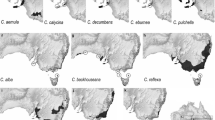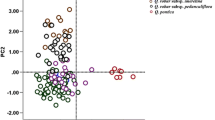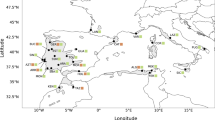Abstract
Variation in ITS and the two chloroplast markers rpl16 and tRNA-Gly was studied to explore phylogeographic patterns in, especially, western Eurasiatic Cratoneuron filicinum (Hedw.) Spruce. ITS and chloroplast data yield incongruent results and are therefore analysed separately; recombination is indicated for ITS. For both data sets one group of haplotypes is widespread in western Eurasia. Another is found in the Mediterranean region and occurs in southern Scandinavia (ITS) or large portions of northern Europe, but is missing in central Europe. It is suggested that the northern populations of the latter haplotypes have dispersed from eastern or south-eastern glacial refugia. At the continental scale, south-east Asiatic populations differ from those in western Eurasia, with an apparent meeting zone west of the Himalayas. American haplotypes are most similar to some European ones according to ITS, but to south-east Asiatic ones according to chloroplast data.



Similar content being viewed by others
References
Akhani H, Kürschner H (2004) An annotated and updated checklist of the Iranian bryoflora. Cryptogam, Bryol 25:315–347
Browicz K (1989) Chorology of the Euxinian and Hyrcanian element in the woody flora of Asia. Plant Syst Evol 162:305–314
Bruen TC, Hervé P, Bryant D (2006) A simple and robust statistical test for detecting the presence of recombination. Genetics 172:2665–2681
Chuah-Petiot MS (1995) Data to the bryoflora of Mount Kenya, Kenya. Trop Bryol 10:41–53
Clement M, Posada D, Crandall KA (2000) TCS: a computer program to estimate gene genealogies. Mol Ecol 9:1657–1659
Crum H, Anderson LE (1981) Mosses of eastern North America. Columbia University Press, New York
Denk T, Grimm G (2010) The oaks of western Eurasia: traditional classifications and evidence from two nuclear markers. Taxon 59:351–366
Dering M, Lewandowski A (2009) Finding the meeting zone: where have the northern and southern ranges of Norway spruce overlapped? For Ecol Manag 259:229–235
Eggers J (1982) Artenliste der Moose Makaronesiens. Cryptogam, Bryol Lichénol 3:283–335
Farris JS, Källersjö M, Kluge AG, Bult C (1995) Testing significance of incongruence. Cladistics 10:315–319
Frey W, Kürschner H (1991) Conspectus bryophytorum Orientalum et Arabicorum. Bryophyt Biblioth 39:1–181
Frey W, Kürschner H (2010) New and noteworthy records to the bryophyte flora of Iran. Nov Hedwig 90:503–512
Good R (1974) The geography of the flowering plants. Longman, London
Hedderson TA, Nowell TL (2006) Phylogeography of Homalothecium sericeum (Hedw.) Br. Eur.; toward a reconstruction of glacial survival and postglacial migration. J Bryol 28:283–292
Hedenäs L (2003a) Amblystegiaceae (Musci). Fl Neotrop Monogr 89:i–iv, 1–107
Hedenäs L (2003b) The European species of the Calliergon-Scorpidium-Drepanocladus complex, including some related or similar species. Meylania 28:1–116
Hedenäs L (2008a) Molecular variation and speciation in Antitrichia curtipendula s.l. (Leucodontaceae, Bryophyta). Bot J Linn Soc 156:341–354
Hedenäs L (2008b) Molecular variation in Drepanocladus aduncus s.l. does not support recognition of more than one species in Europe. J Bryol 30:108–120
Hedenäs L (2009a) Haplotype variation of relevance to global and European phylogeography in Sarmentypnum exannulatum (Bryophyta: Calliergonaceae). J Bryol 31:145–158
Hedenäs L (2009b) Relationships among Arctic and non-Arctic haplotypes of the moss species Scorpidium cossonii and Scorpidium scorpioides (Calliergonaceae). Plant Syst Evol 277:217–231
Hedenäs L (2010a) Global relationships and European phylogeography in the Kindbergia praelonga complex (Brachytheciaceae, Bryophyta). Trop Bryol 31:81–90
Hedenäs L (2010b) Phylogeography and origin of European Sanionia uncinata (Amblystegiaceae, Bryophyta). Syst Biodivers 8:177–191
Hedenäs L (2011) Relationships among Cratoneuron curvicaule, C. filicinum var. filicinum, and C. filicinum var. atrovirens (Bryophyta: Amblystegiceae). J Bryol 33:99–104
Hedenäs L (2012) Global phylogeography in Sanionia uncinata (Amblystegiaceae, Bryophyta). Bot J Linn Soc 168:19–42
Heinrichs J, Hentschel J, Feldberg K, Bombosch A, Schneider H (2009) Phylogenetic biogeography and taxonomy of disjunctly distributed bryophytes. J Syst Evol 47:497–508
Hewitt G (2000) The genetic legacy of the Quaternary ice ages. Nature 405:907–913
Hultén E, Fries M (1986) Atlas of North European vascular plants: north of the Tropic of Cancer, I-III. Koeltz Scientific Books, Königstein
Huson DH, Bryant D (2006) Application of phylogenetic networks in evolutionary studies. Mol Biol Evol 23:254–267
Ignatov MS, Afonina OM, Ignatova EA (2006) Check-list of mosses of East Europe and North Asia. Arctoa 15:1–130
Jordan WC, Courtney MW, Neigel JE (1996) Low levels of infraspecific genetic variation at a rapidly evolving chloroplast DNA locus in North American Duckweeds (Lemnaceae). Am J Bot 83:430–439
Kis G (1985) Mosses of south-east tropical Africa. Institute of Ecology and Botany of the Hungarian Academy of Sciences, Vácrátot
Laenen B, Désamoré A, Devos N, Shaw AJ, González-Mancebo JM, Carine MA, Vanderpoorten A (2010) Macaronesia: a source of hidden genetic diversity for post-glacial recolonization of western Europe in the leafy liverwort Radula lindenbergiana. J Biogeogr 38:631–639
Leroy SAG, Arpe K (2007) Glacial refugia for summer-green trees in Europe and south-west Asia as proposed by ECHAM3 time-slice atmospheric model simulations. J Biogeogr 34:2115–2128
Mishler BD, Oliver MJ (2009) Putting Physcomitrella patens on the tree of life: the evolution and ecology of mosses. In: Knight C, Perroud P-F, Cove D (eds) The moss Physcomitrella patens. Annual Plant Reviews, vol 36. Blackwell Publishing Ltd., West Sussex, pp 1–15
Noguchi A (1991) Illustrated moss flora of Japan. Part 4. The Hattori Botanical Laboratory, Nichinan-shi
Normand S, Ricklefs RE, Skov F, Bladt J, Tackenberg O, Svenning J-C (2011) Postglacial migration supplements climate in determining plant species ranges in Europe. Proc R Soc London, Ser B 278:3644–3653
Ochyra R (1989) Animadversions on the moss genus Cratoneuron (Sull.) Spruce. J Hatt Bot Lab 67:203–242
Ochyra R (1994) African mosses: I. Cratoneuron (Cratoneuraceae). Fragm Flor Geobot 39:137–146
O’Shea BJ (2006) Checklist of the mosses of sub-Saharan Africa (version 5, 12/06). Trop Bryol Res Rep 6:1–252
Pacak A, Szweykowska-Kulińska Z (2000) Molecular data concerning alloploid character and the origin of chloroplast and mitochondrial genomes in the liverwort species Pellia borealis. J Plant Biotechnol 2:101–108
Ros RM, Cano MJ, Guerra J (1999) Bryophyte checklist of northern Africa. J Bryol 21:207–244
Sanmartin I (2003) Dispersal vs. vicariance in the Mediterranean: historical biogeography of the Plaearctic Pachydeminae (Coleoptera, Scarabaeoidea). J Biogeogr 30:1883–1897
Schmitt T, Krauss J (2004) Reconstruction of the colonization route from glacial refugium to the northern distribution range of the European butterfly Polyommatus coridon (Lepidoptera: Lycaenidae). Divers Distrib 10:271–274
Schofield WB (1992) Bryophyte distribution patterns. In: Bates JW, Farmer AM (eds) Bryophytes and lichens in a changing environment. Clarendon Press, Oxford, pp 101–130
Schuster RM (1983) Phytogeography of the Bryophyta. In: Schuster RM (ed) New Manual of Bryology, vol 1. The Hattori Botanical Laboratory, Nichinan, pp 463–626
Shaw AJ (2000) Molecular phylogeography and cryptic speciation in the mosses, Mielichhoferia elongata and M. mielichhoferiana (Bryaceae). Mol Ecol 9:595–608
Shaw AJ, Allen BH (2000) Phylogenetic relationships, morphological incongruence, and geographic speciation in the Fontinalaceae (Bryophyta). Mol Syst Evol 16:225–237
Shaw AJ, Werner O, Ros RM (2003) Intercontinental Mediterranean disjunct mosses: morphological and molecular patterns. Am J Bot 90:540–550
Shaw AJ, Melosik I, Cox CJ, Boles SB (2005) Divergent and reticulate evolution in closely related species of Sphagnum section Subsecunda. Bryologist 108:363–376
Stech M, Werner O, González-Mancebo JM, Patiño J, Sim–Sim M, Fontinha S, Hildebrandt I, Ros RM (2011) Phylogenetic inference in Leucodon Schwägr. subg. Leucodon (Leucodontaceae, Bryophyta) in the North Atlantic region. Taxon 60:79–88
Streimann H, Klazenga N (2002) Catalogue of Australian mosses. Flora Aust Suppl Ser 17:1–259
Taberlet P, Fumagalli L, Wust-Saucy A-G, Cosson J-F (1998) Comparative phylogeography and postglacial colonization routes in Europe. Mol Ecol 7:453–464
Thompson JD, Gibson TJ, Plewniak F, Jeanmougin F, Higgins DG (1997) The ClustalX windows interface: flexible strategies for multiple sequence alignment aided by quality analysis tools. Nucleic Acids Res 24:4876–4882
Vohra JN (1983) Hypnobryales suborder Leskeineae (Musci) of the Himalayas. Rec Bot Surv India 23:1–336
Wigginton MJ (2001) A small collection of bryophytes from Ethiopia. Trop Bryol 20:27–29
Yu-Huan W, Chien G, Wei L (2008) Amblystegiaceae. In: Ren-Liang H, You-fang W, Crosby MR, He S (eds) Moss flora of China. English version. Vol 7. Amblystegiaceae-Plagiotheciaceae. Science Press & Missouri Botanical Garden Press, Beijing & St. Louis, pp 3–67
Zare H, Akbarinia M, Hedenäs L, Maassumi AA (2011) Eighteen mosses from the Hyrcanian forest region new to Iran. J Bryol 33:62–65
Acknowledgments
I thank Keyvan Mirbakhsh for her very efficient laboratory work.
Author information
Authors and Affiliations
Corresponding author
Rights and permissions
About this article
Cite this article
Hedenäs, L. Molecular differentiation within European Cratoneuron filicinum, and differences from Asiatic and American populations. Plant Syst Evol 298, 937–945 (2012). https://doi.org/10.1007/s00606-012-0603-y
Received:
Accepted:
Published:
Issue Date:
DOI: https://doi.org/10.1007/s00606-012-0603-y




